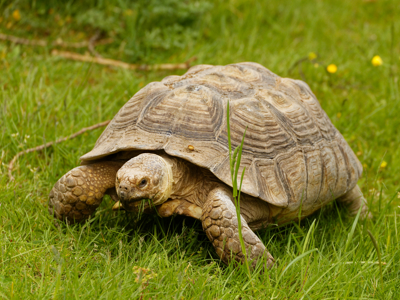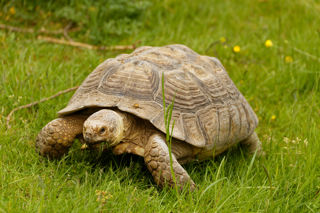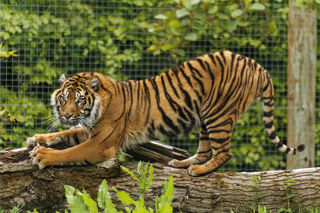
African Spurred Tortoise
The African spurred tortoise is the largest African mainland tortoise, surpassed only by its relative the Aldabra tortoise found on nearby islands. They have a well camouflaged brown-yellow shell with pale skin. Their name comes from the two or three large spurs on the thighs of their back legs.

These tortoises live in burrows and are mostly active during the rainy season when the plants flourish. As they are a cold blooded animal, after a cold night they spend the morning sunbathing to warm up, before moving off to find food. They are a solitary species and can behave very aggressively towards each other.
During the breeding season the males will become more aggressive than usual, ramming each other repeatedly, which will sometimes cause serious injuries. The female will dig out a selection of burrows before deciding on the one she will use. After laying her eggs the female buries them.

Their diet consists of vegetation such as grasses, shrubs and cacti. As they eat a variety of succulent plants they don’t need to drink much water.
The spurred tortoise is classed as Vulnerable by the IUCN, and is threatened by habitat loss due to urbanisation and over grazing by livestock. Capture for the pet trade and use of body parts to make longevity potions are also causing pressure on numbers. It can take up to 15 years for a tortoise to mature and breed, so there are concerns that their population may not be able to recover.
Key Facts:
Conservation Status: Vulnerable
Distribution: Northern Africa
Habitat: Desert, Savannah
Diet: Flowers, Grasses, Herbs, Leaves
Weight: 105kg
No. of young: 15 – 30
Life Span: 50 – 55 years

SUPPORT OUR ANIMALS
If you're looking for an alternative way to donate to Twycross Zoo, you can help support our animals and our zoo keepers by purchasing something from our Amazon Wishlist!
Updated regularly by our zoo keepers, the items on the list help to provide enrichment for our animals and keep their habitats well maintained.
Every donation helps us as a conservation charity.
